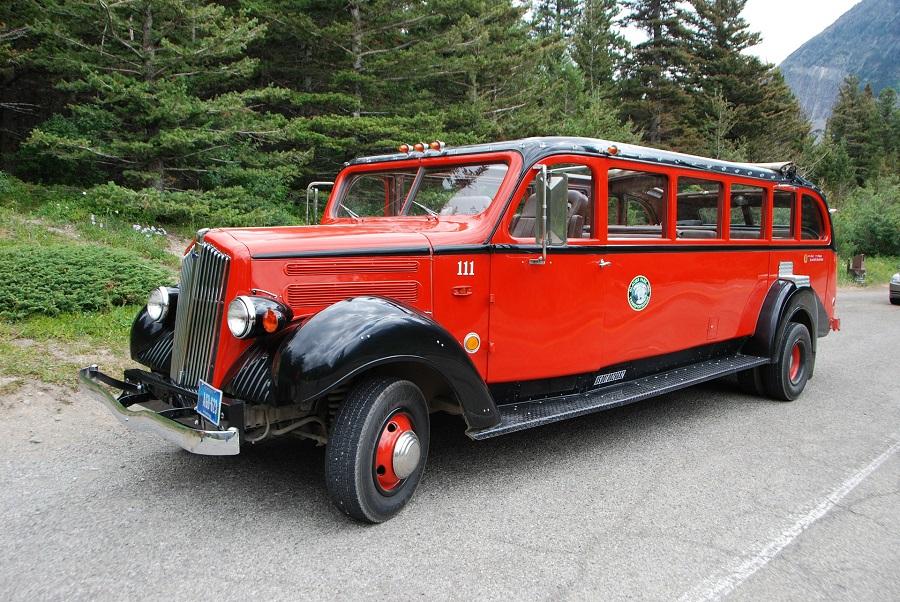
Glacier National Park's famed Red Buses will get overhauled this year/Pixabay
For those visiting Glacier National Park, the iconic red buses remain a trip favorite. Black and crimson, shiny, and comfortable, the buses transport their riders back in time. However, even they need some modern upkeep, and park staff begin an extensive rehabilitation project this year.
The White Motor Company Model 706 buses were manufactured between 1936 and 1939, painted the color of ripe mountain ash berries, and originally purchased by the Glacier Park Transportation Company. The Ford Motor Company donated time and money for the previous red bus rehabilitation, which occurred in 1999.
The rehabilitation will replace the current Ford engines with a Ford 6.2L V8 engine assisted by an electric hybrid system to reduce fuel consumption and emissions. The electric hybrid system will be powered by a battery bank that will charge when the vehicle decelerates including on downhill runs, which are frequent in the park. The buses will be remounted on new Ford chassis retaining the existing 176’ wheelbase, as they were with a previous restoration. Tire size will be expanded from 16’’ to 19.5’’ to approach historical dimensions. The dashboard and gauges will be replaced with historic replicas, and the buses will undergo refinishing, including rust removal and painting using the historic mountain ash color.
President Taft designated Glacier National Park in 1910, making Glacier the 10th unit in the national park system. The red buses have been a signature fixture in the visitor experience for the vast majority of the park’s history. The improvements will ensure that the fleet continues to operate in Glacier National Park for the foreseeable future, with improved safety and serviceability, while retaining the same visitor experience in the park that has existed for over 80 years.
The National Park Service included the rehabilitation as a responsibility in the most recent concession contract that Xanterra Travel Collection was awarded in 2014. Xanterra Travel Collection has selected Legacy Classic Trucks, based in Driggs, Idaho, to do the rehabilitation. Once complete, visitors will once again be able to choose tours that last 2.5-9.5 hours, taking in the beautiful sights and sounds of Glacier National Park.
One recent rider – Steve – says it all in his review on Trip Advisor: “My wife and I recently visited Glacier NP. We took the Red Bus Tour and it was the highlight of our visit. The old restored White Truck Red Buses held 17 guests and had an open top which is open if the weather is agreeable. Thankfully it was while we were there. Our tour guide GLEN was extremely [knowledgeable] about the park, the history, plants, animals, etc. We can't thank him enough for the wonderful experience. Anyone visiting GNP should take this tour. It is worth every penny.”



Comments
While I am a bit surprised you haven't issued an admonishment to tone it down, well played!
From 20,000 feet, I think it's a discussion worth having.
No y_p_w, I am not here to be negative. I am here to learn about the parks and discuss the best way to support and maintain them. As part of that process I believe it useful to point out some of the hypocracy. People frequently complain here about the lack of maintenance but to "feel good" will spend money on items that reflect an inefficient use of the monies that are available. Unfortunately, this is a phenomenon that is not restricted to the parks.
The solution to properly funding NPS maintenance lies with Congress. That will cost money, whether it comes from taxes or fees.
As for the actual work, I re-read several articles that I previously read as reference for posting here. The work was required by the concessionaire (Xanterra) as part of their contract. Ford's input is unclear, but I wouldn't be surprised if they donated the powertrains.
Yes, the solution always seems to be more money. God forbid we spend what we have more wisely.
Sorry to stick my nose into this fascinating conversation about drivetrains and fuel sources, but asking Congress to spend money wisely is a big, big ask.
Spending money on improving the efficiency of an engine appears wise. And the red busses in Glacier each seat 17 people, compared with approximately 1 to 5 in the average POV.
And, yes, Eric, both you and I have spent way too much time being negative here over the years. We both have our internal justifications, but often enough others have complained about both you and I being negative that it is a fact to many.
NPS managed to get the concessionaire to overhaul them, and before that they managed to get Ford to donate the powertrains and expertise, along with a couple of nonprofits to fund the rest. I'm wondering how that becomes controversial.
But of course with budgets, we're dealing with someone in a particularly high office complaining about the supposed lack of fire mitigation, while his own people would like to cut the Forest Service, BLM, and NPS budget that would go to doing just that. As well as withhold future aid to fire mitigation for a supposedly inability to mitigate fire risk. There's logic for ya.